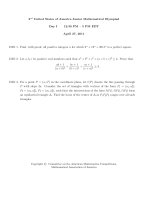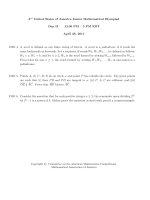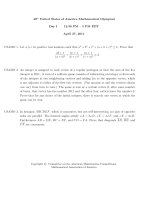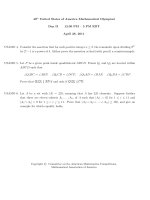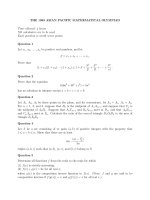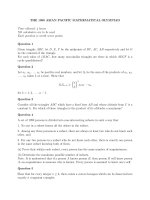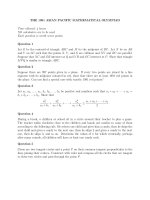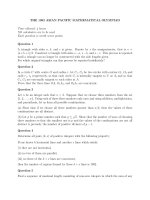ĐỀ THI TOÁN APMO (CHÂU Á THÁI BÌNH DƯƠNG)_ĐỀ 8 pps
Bạn đang xem bản rút gọn của tài liệu. Xem và tải ngay bản đầy đủ của tài liệu tại đây (80.23 KB, 5 trang )
Problem 1. Let n be a positive integer. Find the largest nonnegative real number f(n)
(depending on n) with the following property: whenever a
1
, a
2
, . . . , a
n
are real numbers
such that a
1
+ a
2
+ ··· + a
n
is an integer, there exists some i such that | a
i
−
1
2
|≥ f(n).
(Solution) The answer is
f(n) =
0 if n is even,
1
2n
if n is odd.
First, assume that n is even. If a
i
=
1
2
for all i, then the sum a
1
+ a
2
+ ··· + a
n
is an
integer. Since | a
i
−
1
2
|= 0 for all i, we may conclude f(n) = 0 for any even n.
Now assume that n is odd. Suppose that | a
i
−
1
2
|<
1
2n
for all 1 ≤ i ≤ n. Then, since
n
i=1
a
i
is an integer,
1
2
≤
n
i=1
a
i
−
n
2
≤
n
i=1
a
i
−
1
2
<
1
2n
· n =
1
2
,
a contradiction. Thus |a
i
−
1
2
| ≥
1
2n
for some i, as required. On the other hand, putting
n = 2m + 1 and a
i
=
m
2m+1
for all i gives
a
i
= m, while
a
i
−
1
2
=
1
2
−
m
2m + 1
=
1
2(2m + 1)
=
1
2n
for all i. Therefore, f(n) =
1
2n
is the best possible for any odd n.
Problem 2. Prove that every positive integer can be written as a finite sum of distinct
integral powers of the golden mean τ =
1+
√
5
2
. Here, an integral power of τ is of the form
τ
i
, where i is an integer (not necessarily positive).
(Solution) We will prove this statement by induction using the equality
τ
2
= τ + 1.
If n = 1, then 1 = τ
0
. Suppose that n −1 can be written as a finite sum of integral powers
of τ, say
n − 1 =
k
i=−k
a
i
τ
i
, (1)
where a
i
∈ {0, 1} and n ≥ 2. We will write (1) as
n − 1 = a
k
···a
1
a
0
.a
−1
a
−2
···a
−k
. (2)
For example,
1 = 1.0 = 0.11 = 0.1011 = 0.101011.
Firstly, we will prove that we may assume that in (2) we have a
i
a
i+1
= 0 for all i with
−k ≤ i ≤ k − 1. Indeed, if we have several occurrences of 11, then we take the leftmost
such occurrence. Since we may assume that it is preceded by a 0, we can replace 011
with 100 using the identity τ
i+1
+ τ
i
= τ
i+2
. By doing so repeatedly, if necessary, we will
eliminate all occurrences of two 1’s standing together. Now we have the representation
n − 1 =
K
i=−K
b
i
τ
i
, (3)
where b
i
∈ {0, 1} and b
i
b
i+1
= 0.
If b
0
= 0 in (3), then we just add 1 = τ
0
to both sides of (3) and we are done.
Suppose now that there is 1 in the unit position of (3), that is b
0
= 1. If there are two
0’s to the right of it, i.e.
n − 1 = ···1.00 ··· ,
then we can replace 1.00 with 0.11 because 1 = τ
−1
+ τ
−2
, and we are done because we
obtain 0 in the unit position. Thus we may assume that
n − 1 = ···1.010 ··· .
Again, if we have n − 1 = ···1.0100 ···, we may rewrite it as
n − 1 = ···1.0100 ··· = ···1.0011 ··· = ···0.1111 ···
and obtain 0 in the unit position. Therefore, we may assume that
n − 1 = ···1.01010 ··· .
Since the number of 1’s is finite, eventually we will obtain an occurrence of 100 at the end,
i.e.
n − 1 = ···1.01010 ···100.
Then we can shift all 1’s to the right to obtain 0 in the unit position, i.e.
n − 1 = ···0.11 ···11,
and we are done.
Problem 3. Let p ≥ 5 be a prime and let r be the number of ways of placing p checkers
on a p ×p checkerboard so that not all checkers are in the same row (but they may all be
in the same column). Show that r is divisible by p
5
. Here, we assume that all the checkers
are identical.
(Solution) Note that r =
p
2
p
− p . Hence, it suffices to show that
(p
2
− 1)(p
2
− 2) ···(p
2
− (p − 1)) − (p − 1)! ≡ 0 (mod p
4
). (1)
Now, let
f(x) := (x − 1)(x − 2) ···(x − (p − 1)) = x
p−1
+ s
p−2
x
p−2
+ ··· + s
1
x + s
0
. (2)
Then the congruence equation (1) is same as f(p
2
)−s
0
≡ 0 (mod p
4
). Therefore, it suffices
to show that s
1
p
2
≡ 0 (mod p
4
) or s
1
≡ 0 (mod p
2
).
Since a
p−1
≡ 1 (mod p) for all 1 ≤ a ≤ p − 1, we can factor
x
p−1
− 1 ≡ (x − 1)(x − 2) ···(x − (p − 1)) (mod p). (3)
Comparing the coefficients of the left hand side of (3) with those of the right hand side
of (2), we obtain p |s
i
for all 1 ≤ i ≤ p − 2 and s
0
≡ −1 (mod p). On the other hand,
plugging p for x in (2), we get
f(p) = (p − 1)! = s
0
= p
p−1
+ s
p−2
p
p−2
+ ··· + s
1
p + s
0
,
which implies
p
p−1
+ s
p−2
p
p−2
+ ··· + s
2
p
2
= −s
1
p.
Since p ≥ 5, p |s
2
and hence s
1
≡ 0 (mod p
2
) as desired.
Problem 4. Let A, B be two distinct points on a given circle O and let P be the midpoint
of the line segment AB. Let O
1
be the circle tangent to the line AB at P and tangent to
the circle O. Let be the tangent line, different from the line AB , to O
1
passing through
A. Let C be the intersection point, different from A, of and O. Let Q be the midpoint
of the line segment BC and O
2
be the circle tangent to the line BC at Q and tangent to
the line segment AC. Prove that the circle O
2
is tangent to the circle O.
(Solution) Let S be the tangent point of the circles O and O
1
and let T be the intersection
point, different from S, of the circle O and the line SP . Let X be the tangent point of
to O
1
and let M be the midpoint of the line segment XP . Since ∠T BP = ∠ASP, the
triangle TBP is similar to the triangle ASP. Therefore,
P T
P B
=
P A
P S
.
Since the line is tangent to the circle O
1
at X, we have
∠SPX = 90
◦
− ∠XSP = 90
◦
− ∠AP M = ∠PAM
which implies that the triangle PAM is similar to the triangle SP X. Consequently,
XS
XP
=
MP
MA
=
XP
2MA
and
XP
P S
=
MA
AP
.
From this and the above observation follows
XS
XP
·
P T
P B
=
XP
2MA
·
P A
P S
=
XP
2MA
·
MA
XP
=
1
2
. (1)
Let A
be the intersection point of the circle O and the perpendicular bisector of the chord
BC such that A, A
are on the same side of the line BC, and N be the intersection point
of the lines A
Q and CT . Since
∠NCQ = ∠T CB = ∠T CA = ∠T BA = ∠T BP
and
∠CA
Q =
∠CAB
2
=
∠XAP
2
= ∠P AM = ∠SP X,
the triangle NCQ is similar to the triangle TBP and the triangle CA
Q is similar to the
triangle SP X. Therefore
QN
QC
=
P T
P B
and
QC
QA
=
XS
XP
.
and hence QA
= 2QN by (1). This implies that N is the midpoint of the line segment
QA
. Let the circle O
2
touch the line segment AC at Y . Since
∠ACN = ∠ACT = ∠BCT = ∠QCN
and |CY | = |CQ|, the triangles Y CN and QCN are congruent and hence NY ⊥ AC and
NY = NQ = NA
. Therefore, N is the center of the circle O
2
, which completes the proof.
Remark : Analytic solutions are possible : For example, one can prove for a triangle ABC
inscribed in a circle O that AB = k(2 + 2t), AC = k (1 + 2t), BC = k(1 + 4t) for some
positive numbers k, t if and only if there exists a circle O
1
such that O
1
is tangent to the
side AB at its midpoint, the side AC and the circle O.
One obtains AB = k
(1 + 4t
), AC = k
(1 + 2t
), BC = k
(2 + 2t
) by substituting
t = 1/4t
and k = 2k
t
. So, there exists a circle O
2
such that O
2
is tangent to the side BC
at its midpoint, the side AC and the circle O.
In the above, t = tan
2
α and k =
4R tan α
(1+tan
2
α)(1+4 tan
2
α)
, where R is the radius of O and
∠A = 2α . Furthermore, t
= tan
2
γ and k
=
4R tan γ
(1+tan
2
γ)(1+4 tan
2
γ)
, where ∠C = 2γ. Observe
that
√
tt
= tan α · tan γ =
XS
XP
·
P T
P B
=
1
2
, which implies tt
=
1
4
. It is now routine easy to
check that k = 2k
t
.
Problem 5. In a circus, there are n clowns who dress and paint themselves up using a
selection of 12 distinct colours. Each clown is required to use at least five different colours.
One day, the ringmaster of the circus orders that no two clowns have exactly the same set
of colours and no more than 20 clowns may use any one particular colour. Find the largest
number n of clowns so as to make the ringmaster’s order possible.
(Solution) Let C be the set of n clowns. Label the colours 1, 2, 3, . . . , 12. For each
i = 1, 2, . . . , 12, let E
i
denote the set of clowns who use colour i. For each subset S of
{1, 2, . . . , 12}, let E
S
be the set of clowns who use exactly those colours in S. Since S = S
implies E
S
∩ E
S
= ∅, we have
S
|E
S
| = |C| = n,
where S runs over all subsets of {1, 2, . . . , 12}. Now for each i,
E
S
⊆ E
i
if and only if i ∈ S,
and hence
|E
i
| =
i∈S
|E
S
|.
By assumption, we know that |E
i
| ≤ 20 and that if E
S
= ∅, then |S| ≥ 5. From this we
obtain
20 × 12 ≥
12
i=1
|E
i
| =
12
i=1
i∈S
|E
S
|
≥ 5
S
|E
S
| = 5n.
Therefore n ≤ 48.
Now, define a sequence {c
i
}
52
i=1
of colours in the following way:
1 2 3 4 | 5 6 7 8 | 9 10 11 12 |
4 1 2 3 | 8 5 6 7 | 12 9 10 11 |
3 4 1 2 | 7 8 5 6 | 11 12 9 10 |
2 3 4 1 | 6 7 8 5 | 10 11 12 9 | 1 2 3 4
The first row lists c
1
, . . . , c
12
in order, the second row lists c
13
, . . . , c
24
in order, the third
row lists c
25
, . . . , c
36
in order, and finally the last row lists c
37
, . . . , c
52
in order. For each
j, 1 ≤ j ≤ 48, assign colours c
j
, c
j+1
, c
j+2
, c
j+3
, c
j+4
to the j-th clown. It is easy to check
that this assignment satisfies all conditions given above. So, 48 is the largest for n.
Remark : The fact that n ≤ 48 can be obtained in a much simpler observation that
5n ≤ 12 × 20 = 240.
There are many other ways of constructing 48 distinct sets consisting of 5 colours. For
example, consider the sets
{1, 2, 3, 4, 5, 6}, {3, 4, 5, 6, 7, 8}, {5, 6, 7, 8, 9, 10}, {7, 8, 9, 10, 11, 12},
{9, 10, 11, 12, 1, 2}, {11, 12, 1, 2, 3, 4}, {1, 2, 5, 6, 9, 10}, {3, 4, 7, 8, 11, 12}.
Each of the above 8 sets has 6 distinct subsets consisting of exactly 5 colours. It is easy to
check that the 48 subsets obtained in this manner are all distinct.


